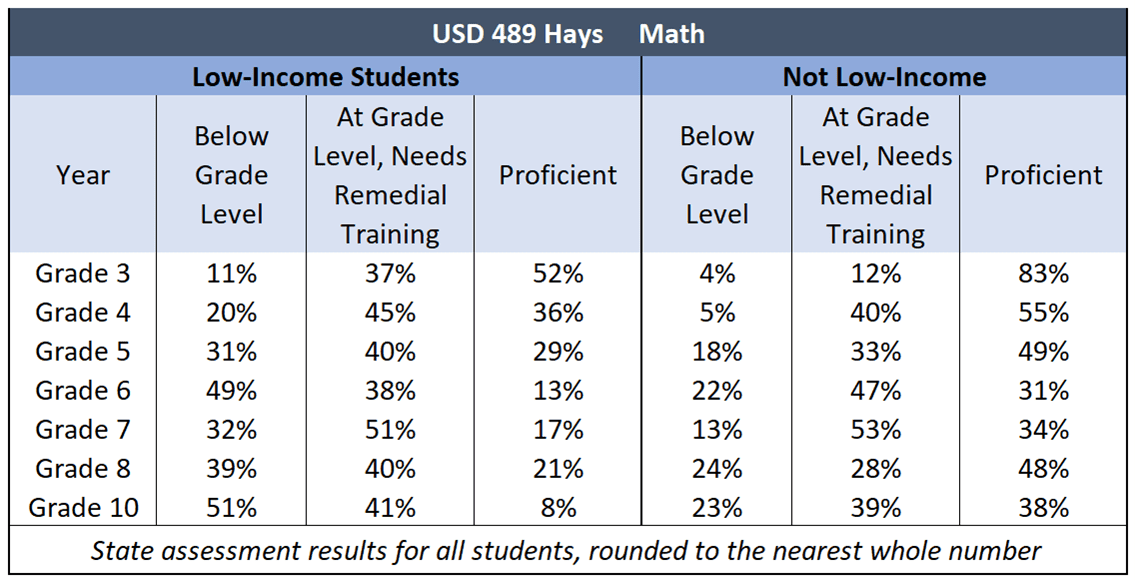The USD 489 Hays website says its mission is “to provide a quality learning experience for every student in every classroom,” yet the 2022 state assessment results show a quarter of all students tested are below grade level in reading and math, and only about four in ten are proficient. The high school results are even worse; in math, for example, 33% are below grade level, and just 30% are proficient.
Given these facts, it’s hard to understand why Superintendent Ron Wilson would attack legislators and others for supporting a school choice bill that provides additional opportunities for students. The Hays Post reported that Hays USD 489 Superintendent Ron Wilson “gave a report to the school board Feb. 20 on what he called crazy legislation that is being championed by legislators who are attacking public education.”
Wilson may consider SB 83 as an attack on public education, but the demand for more opportunities comes from parents who are becoming more aware that student achievement is much lower than they’ve been led to believe. That’s not attacking anyone; it’s about ensuring that every student has a real opportunity to get the education they deserve.
No apparent plan at USD 489 Hays to improve achievement
The Sentinel sent an Open Records request to USD 489, asking for Wilson’s February 20 remarks to the school board, an audio recording of those remarks, and the district’s written plan to achieve the target of 75% proficiency set by the Kansas Department of Education and how long it would take for that to occur.
Wilson first demanded $25 for “costs associated for this records request.” After waiting more than a week for the ‘records’ to be provided after we paid the bill, Wilson sent an email listing the legislation he discussed with the board but not the comments he made. He said the district doesn’t keep recordings of board meetings, and instead of providing the written plan we requested, he wrote, “Proficiency can be achieved when the barriers are removed as listed in section A of district needs assessment. Growth for each student in their learning progression of becoming a successful high school graduate is the every student every day focus of USD489. A successful high school graduate has both the academic and the social/emotional skills needed for postsecondary success.”
That quote comes from Question #3 of the district’s building needs analysis, which is supposed to be published for each school and specify the number of years it will take to get to get students to be proficient in reading and math Hays USD 489 did not publish a report for each building that answers the three questions required in state law; it merely published a generic report for the district, not each school, and the summary report does not identify specific budget actions that will be taken to overcome barriers to students achieving proficiency in reading and math. The Hays report merely says, “Supporting budget requests for time, resources, and staffing to remove, remedy the barriers listed above.”
Asked again for the district’s plan for each building, Wilson provided a link to the accountability reports published for each school, but those reports do not include written plans detailing the specific barriers and steps to be taken.
If Wilson thinks the information in those accountability reports constitutes written strategic plans to improve achievement, he doesn’t understand the basics of strategic planning.
A strategic plan would, for example, would attempt to identify the reasons that proficiency levels drop precipitously from Grade 3 to Grade 10. The 2022 state assessment shows that 52% of low-income students are proficient in math in the third grade but only 36% in the fourth grade. Proficiency declines rather steadily thereafter, and only 8% of low-income students are proficient in the tenth grade.
Many students obviously are not getting the basics they need in the early years, and the board needs input from teachers and principals to collaboratively agree on the corrective actions to be aggressively pursued. But I’ll a bet a fine lunch at the restaurant of Mr. Wilson’s choosing that the Hays board has not seen the adjacent chart or anything like it.
The disconnect in USD 489 Hays is just the latest in a sordid history of education officials ignoring the student achievement crisis in Kansas.
Education officials may think it’s crazy to give other opportunities to parents who cannot afford to pay tuition to private schools, but a lot of parents would like to know how children should be trapped in underperforming schools that show no substantive sign of improvement.





